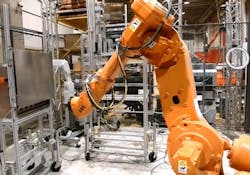Get the Robotics Help You Need
With the fast uptake of robotics across industries over the past decade in particular, there has been a similar growth in related industry groups. One that recently caught our eye is the Advanced Robotics for Manufacturing Institute, also known as the ARM Institute. As a group that positions itself at the intersection of industry, academia and government (as part of Manufacturing USA) the ARM Institute’s approach is considerably broader—and potentially more helpful to manufacturers—than many industry trade organizations.
To get a better understanding of the ARM Institute, we connected with Ira Moskowitz, CEO of the ARM Institute, for a recent episode of the “Automation Gets Your Questions Answered” podcast series. The Q&A that follows features a few highlights of that discussion. You can access the complete podcast via the link above in this paragraph.
David Greenfield, Automation World
Tell us what the ARM Institute and the Manufacturing USA network are and what they mean to manufacturers.
Ira Moskowitz, ARM Institute
The ARM Institute was established in 2017 by Carnegie Mellon University, and we're headquartered in Pittsburgh. But we are a national entity and are one of 17 national Manufacturing USA institutes. Manufacturing USA is a national network that was initiated about 10 years ago and we are certainly a proud member of that.
Members of the ARM Institute include all the largest U.S. defense contractors and we have a dominant share of the major suppliers of robotics to the U.S., but we also have the small and medium-sized companies—from startups in AI and robotics to small manufacturers that use robotics. We also have many of the top U.S. universities doing research in robotics as well as federally funded research and development centers and more than 50 community colleges and vocational high schools that are training the manufacturing technician workforce of tomorrow. And on the government side, we have NIST (National Institute for Standards and Technology), Army, Air Force, Navy and NIOSH (National Institute for Occupations Safety & Health) in our consortium.
To execute our mission, we leverage that very unique ecosystem to bring these technologies to all manufacturers of all sizes across the country. But equally importantly, we seek to educate the workforce to ultimately protect our supply chains and our national security.
This national network of 17 manufacturing institutes is sponsored and partnered in a kind of a whole of government way by the Department of Commerce, Department of Energy and the Department of Defense and all of the institutes have the same mission. We all work to try to help secure U.S. global leadership in advanced manufacturing through these public-private collaborations on technology and advance our supply chains.
But each institute focuses on a specific critical aspect of advanced manufacturing technology and all of them are set up in a similar way in that they each have very important attributes. The first and most important aspect is that each of the institutes gather a consortium of the leading entities and their particular technologies across industry, academia and government. They use this consortium to develop technology together in a kind of pre-competitive collaborative space in a way that's unique and not very possible in any other aspect. They also advance the education of the workforce in manufacturing about specific technologies. This creates a very unique public-private partnership where you have this collaborative pre-competitive space where intellectual property can be shared, but the background intellectual property can be protected.
While the ARM Institute is young, we've executed more 150 projects both in technology and workforce development. And we've managed more than $100 million to date of government money and investments and, by the way, all of that is matched greater than one-to-one by cost share across the entities that are actually executing those projects.
David Greenfield, Automation World
Can you explain more how the cost share aspect of the ARM Institute’s projects work?
Ira Moskowitz, ARM Institute
So what that means is that when we do a project that's funded by government dollars, part of the part of the membership understanding is that people who execute these projects are going to bring their own investment into it. On at least a one-to-one match to the government dollars.
What this does is provide a multiplier effect on our public funds to advance these technologies where they need to be advanced, with the government coming in with their share. Industry and academia come with their share too, and so you have a multiplier effect to do something that would be much more expensive for either industry or government to do alone.
David Greenfield, Automation World
Since the ARM Institute is funded by the Department of Defense, can manufacturers outside of the defense industries access the ARM Institute’s resources?
Ira Moskowitz, ARM Institute
Absolutely. In fact, that is part of the design. The actual concept of this institute is to bring together an entire ecosystem in a way that the Department of Defense (DoD) can't easily access. Our initiatives and projects—both in technology and workforce—are at the intersection of the needs of industry, academia and government.
So even if you're not part of the defense industrial base, when you join the institute and want to work on a project, you get that leverage, that multiplier effect of help from government and academia.
For the DoD side, the institute brings in these entities who have never served the interests of the DoD before—they weren't part of their supply chains. Now they actually become part of the supply chain because they're working on projects that have a defense orientation but are useful to industry.
As an example of this, FedEx is one of our members. And FedEx is typically not part of the defense industrial base and yet they led some of our projects that were very impactful for industry and very helpful to the Department of Defense.
David Greenfield, Automation World
So it's about boosting an organic cross pollination among entities that might not normally interact in manufacturing and defense.
Ira Moskowitz, ARM Institute
Right. We’re bringing together folks that don't typically interact. It's about enabling competitors to work together horizontally because it's pre-competitive IP space where people share the IP.
We also get new supply chains formed vertically. So, you'll get a big OEM contractor like Raytheon or Lockheed Martin and a major university working with a startup that has a bleeding edge technology that they never would have met before. It's about creating these unique partnerships and unique interactions. There really isn't any other model other like this outside of the Manufacturing USA network.
David Greenfield, Automation World
Can you give a couple of examples of how the ARM Institute has helped manufacturers begin deploying or expanding their use of robots?
Ira Moskowitz, ARM Institute
When we do a project, we identify the gap in technology for the manufacturer. We fill that gap by putting the challenge out to the project teams. These teams compete for these projects, and we award the projects based on the best team’s likelihood of success. They decide how they're going to solve the problem.
Most of the projects we get involved with have two-fold benefits to manufacturers: One involves doing things that either can be done better by a robot or taking care of a step in a manufacturing process that may be very dangerous or difficult for a human. Humans are increasingly valuable now because it's so hard to get skilled labor for manufacturing. The other aspect addresses industrial workforce issues. A lot of manufacturers today need more capacity and they need to expand but they can't find the people, and so they need to start automating in order to keep up with demand.
Coming at the projects from these two aspects, you get a lot of AI and machine learning solutions. I'll give you an example of something that is completely dependent on AI and it's one of those tasks that human beings were struggling to do.
Large jet planes have big air inlets that require specific maintenance. To work on these surfaces inside the air inlets, a human had to wear a protective suit and crawl inside the inlet to do the job. It took a long time and was very difficult.
Now, we’ve developed an autonomous robot that connects with a long extension arm to go into that inlet and, through machine learning, understand the inlet’s curved surfaces, understand which parts are damaged and then handle the repairs and maintenance as needed.
By the way, the human that was doing this job before is now outside the inlet helping to operate and maintain that robot.
David Greenfield, Automation World
Based on your experience working in manufacturing and as part of the ARM Institute working with manufacturers, are there common mistakes you've seen manufacturers make when it comes to selecting and implementing robots that you wish more manufacturers were aware of so that those types of mistakes could be avoided?
Ira Moskowitz, ARM Institute
Absolutely. So, where you see the challenges in implementing robotics and automation is really with the small and medium-sized companies that don't have the amount staff need and perhaps are not sure where to start.
One of the most common things you'll see in these companies is a robot arm sitting in the corner somewhere because they thought they needed it and they bought it. And now it's sitting in the corner.
Because of this, one of the first things that small and medium-sized manufacturers need to do is to get help on triaging what their problem is. They may think it's an automation problem or robotics problem, but it may not be. They may have other inefficiencies that need to be dealt with that sound like it requires a robot, but actually the root cause could be something else. So, the very first thing to do is an engineering analysis of the line and verify if you'll actually need a robot.
The second thing is to understand how the robot interacts with the rest of the line. You may be able to automate a step previously done by a human by using a robot, but it could disrupt the entire way that part of production operates. So, you really have to think about how you reengineer the line so that that robot can function efficiently and the rest of the processes can continue to function as needed. You may find that you need some adjustment to processes before and after the robot installation to make that whole process work well.
And the third thing is to realize that robots need maintenance and they need software upgrades. So, you're going to have to find a way to make sure that you're reskilling your staff in order to maintain this.


